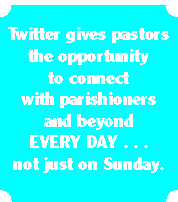In general, the sermon is a dead medium. Quite possibly, a sermon is well-reasoned and based in sound theology. It may impart important information about understanding the text. It may be delivered from the heart even when read.
This is accepted in the world of church. Preachers preach. Congregations listen.
Yet frequently the medium of sermon, central to the church experience, lacks the power that live interaction can give—even though they ARE live! Ironic! Live may not be the most lively!
The temptation, which makes sense, is to preach to the people who are there—to meet the expectations of the people who give their offerings—until the offerings run out.
Today there are far fewer people in church listening. Most of the listeners are over 50 and presumably still have an attention span that lasts longer than 20 minutes (even if our short-term memories are just a memory). There are practically no children in church.
The offerings are going to run out.
Yet the delivery of the 20-minute sermon is still the norm. Preachers preach. Congregations listen. Seminaries are still working hard to teach preachers to do this well.
Some of them do!
Many of them don’t.
One of the faults of the preaching world is that no one reviews or critiques pastors once they complete seminary training. Preachers rarely hear other preachers speak. They are isolated in those pulpits! They are what they are.
There is no place more status quo in the Church than the pulpit.
We listeners at Redeemer have heard a lot of sermons from a lot of pastors. Our versatility in listening to preachers is a by-product of having no pastor most of the time for a decade or so. We had supply pastors. This has continued in our rejected status within the church as we attend other churches and listen to an unending string of “supply” pastors.
In our experience, we have heard some supply pastors give the same sermon unaltered a half-dozen times. We’ve heard a few others ramble about the morning news — preaching the newspaper was the theory. Failure to prepare was often more evident.
We’ve had sermons read to us. We’ve had sermons rambled at us. We have become familiar with formula sermons that build to a climax and drop us right into the post-sermon hymn.
We have heard some good sermons. Good as they were, they aren’t remembered long.
Preaching in a sanctuary is an opportunity to shine—to inspire and reach each set of ears in a personal way. But there is something about the format that no longer resonates with today’s world. It may be too late to recover.
The missing element may be immediacy. Three examples.
We live in a world where news is instantaneous. We are likely to hear it from a stranger nearby—like the guy on a cell phone in the theater lobby during intermission who loudly reports the score of the playoff game to every disgruntled mate who was forced to choose between the theater and the TV screen.
I was in an airplane when the news broke that ObamaCare had passed. Each passenger was busy about their own business, until a young-20-something announced the news. A lively debate was struck crossing the aisles and over the backs of seats. It continued as we filed out the aisle and into the terminal.
I attended a boychoir concert one Sunday afternoon. The choir was very professional and poised. Suddenly, and fortunately in between numbers, the back row of teen boys erupted with inexplicable joy. One of the tenors was wired and had passed the news that the local football favorite had scored a winning touchdown.
News is fresh. Vital. Interesting, Relevant. Necessary to our lives. Catalytic at is finest.
We seem to have lost these qualities in the telling of the Good News.
Delivering the Good News once a week may have fit the slower-paced life of yesteryear. It may still have an important place in today’s world, but it is not the most effective way to reach the most people.
Yet we listeners are locked in. Congregations still pay a hefty fee, often a mission-crippling fee, to make sure there is a preacher present in the sanctuary each week, preaching to a dwindling audience. It is live, but it is not lively.
Blogging, on the other hand, is live in a different sense. It is interactive. It reaches beyond sanctuary walls. It creates a following who are motivated to share. It allows you to address local problems in real time — not waiting until Sunday to muster the energy of the faithful to act. (By then they will probably do little more than pray.) Blogging is THE medium made for modern preachers.
Very, very few have been able to switch gears.
Change comes hard. But it does come. For the art of preaching to survive, it must adapt to the modern audience.
The church audience today is not in church.
We are online. (Click to Tweet)



